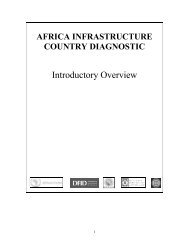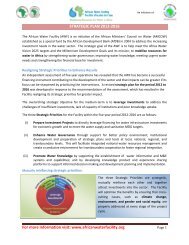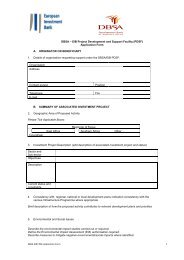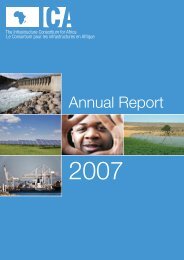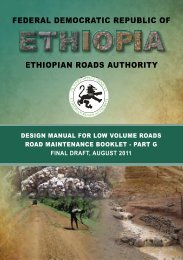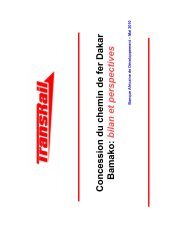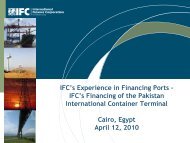Design-Manual-for-Low-Volume-Roads-Part-A
Design-Manual-for-Low-Volume-Roads-Part-A
Design-Manual-for-Low-Volume-Roads-Part-A
You also want an ePaper? Increase the reach of your titles
YUMPU automatically turns print PDFs into web optimized ePapers that Google loves.
Foreword - i<br />
FOREWORD<br />
<strong>Low</strong> volume roads in Ethiopia typically carry less than 300 vehicles per day and provide important links<br />
from homes, villages and farms to markets and offer the public access to health, education and other<br />
essential services. These roads also provide important links between Wereda Centres and the Federal<br />
road network.<br />
Many aspects of the design and construction of roads in Ethiopia, has stemmed from technologies<br />
and practices emanating from Europe and the USA some 40 years ago. These practices have to some<br />
extent been modified in the intervening years, but the basic philosophy of road provision has remained<br />
the same. While these “standard” approaches might still be appropriate <strong>for</strong> much of the main trunk<br />
and link road network, they remain overly conservative, inappropriate and far too costly <strong>for</strong> application<br />
on much of the country’s rural road network. In facing the challenges of improving and expanding<br />
Ethiopia’s low volume rural road network, application of the traditional planning, design, construction<br />
and maintenance approaches cannot provide the solution.<br />
Many innovative practices and unconventional techniques, often developed and proved through<br />
years of research, have not found the degree of application and implementation that they should.<br />
Opportunities are missed that would provide better and lower cost engineering solutions and more<br />
sustainable low volume roads.<br />
There is a wealth of local and international in<strong>for</strong>mation, experience and research that when utilised,<br />
can change current practices and thinking and provide Ethiopia with an appropriate and af<strong>for</strong>dable<br />
low volume road network. To benefit fully from these advances and to see necessary improvements<br />
implemented on the ground, Ethiopian <strong>Roads</strong> Authority (ERA) has developed its first comprehensive<br />
national road design manual, technical specifications and bidding documents specifically <strong>for</strong> low volume<br />
roads. The task was completed with the assistance of a team of international experts commissioned<br />
through DFID’s Africa Community Access Programme (AFCAP).<br />
Compilation of the documents was undertaken in close consultation with the local industry and regional<br />
authorities. The Federal and Regional <strong>Roads</strong> Authorities, the contracting and consulting industry, the<br />
universities, training schools, the road fund and other industry stakeholders all participated in the<br />
<strong>for</strong>mulation of the documentation. Local issues and experience on the geometric, earthwork, drainage,<br />
pavement and surfacing design <strong>for</strong> low volume roads were discussed and debated at length. Of<br />
particular interest were aspects of better use of local materials; materials selection and specification;<br />
testing and improvement of materials; construction methods and the utilisation of approaches such<br />
as labour-based and intermediate equipment technology; route selection; works specifications; and<br />
contracting of small works. Much of this debate and other resource materials developed during the<br />
compilation of the manual have been captured and are available from the ERA website: www.era.gov.et<br />
Importantly, in supporting the preparation of the documents, a series of thematic peer review panels<br />
were established that comprised local experts from the public and private sector who provided guidance<br />
and review <strong>for</strong> the project team. Mainstreaming of social and cross-cutting aspects received special<br />
attention and a peer panel of local experts developed a welcome addition to the design process in<br />
terms of complementary interventions.<br />
On behalf of the Ethiopian <strong>Roads</strong> Authority I would like to take this opportunity to thank DFID, Crown<br />
Agents and the AFCAP team <strong>for</strong> their cooperation, contribution and support in the development of<br />
the low volume roads manual and supporting documents <strong>for</strong> Ethiopia. I would also like to extend my<br />
gratitude and appreciation to all of the industry stakeholders and participants who contributed their<br />
time, knowledge and ef<strong>for</strong>t during the development of the documents. Special thanks are extended to<br />
the members of the various Peer Panels whose active support and involvement guided the lead authors<br />
and the process.<br />
FOREWORD




